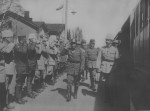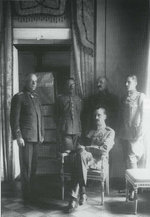
Finland
| Full Name | 11 Republic of Finland | |
| Alliance | Axis - Minor Member Nation or Possession | |
| Entry into WW2 | 30 Nov 1939 | |
| Population in 1939 | 3,700,000 | |
| Military Deaths in WW2 | 95,000 | |
| Civilian Deaths in WW2 | 2,000 | |
| - Civ Deaths from Holocaust | 15 |
Contributor: C. Peter Chen
ww2dbaseIn 1918, Finland ended over 100 years of Russian rule and gained independence. Political tension between the two countries remained tense through the 1920s and 1930s.
ww2dbaseOn 28 Sep 1939, Germany and Russia signed the Molotov-Ribbentrop Pact, which included a secret clause that divided parts of Europe under German and Russian spheres of influence. With Finland falling under Russian sphere of influence, Russia invaded Finland on 30 Nov, starting the Winter War. Russian forces wielded greater numbers and greater firepower, including air superiority, thus leaders in Moscow thought victory would be obtained between two to four weeks. The Finns, however, fought back with tenacity, aided by terrain that strongly favored the defenders. The Finns defeated the Russians at several key battles, while being supported by the United Kingdom, France, and Sweden continued to provide Finnish troops sources of greater morale. By Mar 1940, however, Russian forces began to gain the upper hand. By this point, Finland wanted to end the war before its supplies waned, while Russia wanted to save face from not being able to conquer Finland within several weeks as expected, thus the two nations negotiated for peace. At the Moscow Peace Treaty of 12 Mar 1940, the Winter War ended with Finland giving up territory including Finnish Karelia.
ww2dbaseAlthough the Winter War had ended, Finland continued to build up arms as if it never did. Politically, Finland attempted to arrange mutual defense pacts with Sweden and the United Kingdom, but none of the negotiations came to fruition, and the Finns turned to the Germans, who welcomed the friendship as an invasion of the Soviet Union was being planned. German troops arrived in Finland, mostly in Lapland (Lappi).
ww2dbaseOn 22 Jun 1941, Germany launched Operation Barbarossa in Eastern Europe against the Soviet Union, while in Northern Europe German troops based in Finland also crossed the border under Operation Silberfuchs (Silver Fox). On 25 Jun, Russian forces launched major air raids against Finnish cities, leading to the official declaration of war on Russia by Finland, thus starting the Continuation War. By fall of 1941, Finnish troops had reclaimed, and went beyond, the territories lost at the end of the Winter War, occupying most of Russian East Karelia, but as winter approached the Finns set up defensive positions and ceased their general offensive. On 6 Dec, the United Kingdom declared war on Finland. During the occupation of Russian East Karelia, the Finnish Army set up concentration camps to house those perceived as threats to the occupation, and about 4,000 died in these camps largely due to malnourishment. The Finns played a part in the Siege of Leningrad during the war.
ww2dbaseDuring this period of Finnish-German cooperation (note that Finland never officially joined the Axis alliance), Finland fulfilled much of its needs on food, fuel, and weapons from Germany. Unlike some of the nations influenced by German policies, Finland did not systematically persecute Jews.
ww2dbaseOn 16 Mar 1944, Franklin Roosevelt, President of the United States, called for Finland to disassociate from Germany. On 9 Jun 1944, Russian forces launched an offensive against Finland, reaching approximately the Finnish-Russian borders as of the end of the Winter War. Finnish President Risto Ryti resigned in Aug 1944, and the Finnish commander-in-chief Carl Gustaf Emil Mannerheim assumed power. Unlike Ryti, who preferred a closer relationship with Germany, Mannerheim moved to open communications with Moscow. He recognized that Russia was still fighting a bitter war with Germany, and Finland must negotiate for peace while Russia was still pre-occupied in that theater. On 4 Sep, Finland announced its intention to break apart from Germany, and on the same date the ceasefire between the two countries took effect. A week later, Finland declared war on Germany, starting the Lapland War. The Moscow Armistice was signed on 19 Sep 1944 with similar terms as the treaty that ended the Winter War, with an additional major loss being Petsamo, known for rich nickel deposits and where Finland's only ice-free northern ports could be found. A harsh reparation of $300,000,000 was also placed upon the Finns (although it is interesting to note that Finland was able to rebuild its economy so quickly that the reparations were actually paid in full by 1952). Finally, Russia took control of the Porkkala area near Helsinki to build a military base, and remained there until 1956. With the peace with Russia achieved before the final days of the European War, Finland was saved from becoming a Soviet puppet state. However, the loss of territory to Russia meant the loss of the city of Vyborg, and about an eighth of the Finnish population had to be relocated.
ww2dbaseDuring the Lapland War, Finnish forces fought in northern Finland with the aim of driving German forces out. The fighting was initially cautious, with Germany and Finland negotiating for a timetable for the German evacuation of northern Finland, but Russian soon demanded Finland to take more aggressive actions. The Finns soon complied. In response, the retreating Germans adopted a scorched earth policy, destroying buildings and infrastructure as they retreated, forcing 100,000 people out of their homes. During the Lapland War, Finland lost 1,000 troops and Germany lost about 2,000.
ww2dbaseBetween 1939 and 1945, 80,000 Finns, mostly children, were evacuated abroad; most of them went to Sweden, while a smaller percentage went to Denmark and Norway. Most of the children returned by 1948, though 15% to 20% of them remained with their foster families.
ww2dbaseSource: Wikipedia.
Last Major Update: Aug 2008
| People | ||
| Aho, Martti | Lennart Oesch | Pajari, Aaro |
| Airo, Aksel | Luukkonen, Fanni | Ryti, Risto |
| Heinrichs, Erik | Mannerheim, Carl G. E. | Siilasvuo, Hjalmar |
| Häyhä, Simo | Marttinen, Alpo | Öhquist, Harald |
| Events Taken Place in Finland | ||
| The Winter War | 30 Nov 1939 - 13 Mar 1940 | |
| Battle of Tali-Ihantala and Battle of Vuosalmi | 21 Jun 1944 - 17 Jul 1944 | |
| Finland Switched Sides | 4 Sep 1944 - 15 Sep 1944 | |
| Ships | ||||
| Ilmarinen | Väinämöinen | |||
| Weapons | ||
| KP/-31 Submachine Gun | Lahti-Saloranta M/26 Machine Gun | |
Photographs
 |  |  |  |
Finland in World War II Interactive Map
Please consider supporting us on Patreon. Even $1 per month will go a long way! Thank you. Please help us spread the word: Stay updated with WW2DB: |
Visitor Submitted Comments
5 Mar 2009 09:02:07 AM
Minor grammar error. The last sentence in the first paragraph should read:
Political tension between the two countries remained tense through the 1920s and 1930s.
20 Nov 2011 01:31:43 PM
Actually, Finland declared itself independent from Russia in 1917 (not 1918 as stated in the article).
4 Oct 2015 09:27:20 AM
Finland did not take part in siege of Leningrad. Hitler asked Finland to do it but our Commander In Chief, Marshal Of Finland, Baron C.G.E Mannerheim said:no we will not take part in it.
All visitor submitted comments are opinions of those making the submissions and do not reflect views of WW2DB.

- » Wreck of Teruzuki Found (27 Jul 2025)
- » USS Orlean's Bow Found (22 Jul 2025)
- » The Emperor of Japan Planned to Honor WW2-era Japanese POWs in Mongolia (4 Jul 2025)
- » US State Lawmaker John Winter Caught Using Racial Slur "Jap" and Apologized (11 Jun 2025)
- » US Government Plans to Purge WW2 Information (17 Mar 2025)
- » See all news
- » 1,182 biographies
- » 337 events
- » 45,119 timeline entries
- » 1,249 ships
- » 350 aircraft models
- » 207 vehicle models
- » 376 weapon models
- » 123 historical documents
- » 261 facilities
- » 470 book reviews
- » 28,412 photos
- » 365 maps
Fleet Admiral Chester W. Nimitz, 16 Mar 1945
Please consider supporting us on Patreon. Even $1 a month will go a long way. Thank you!
Or, please support us by purchasing some WW2DB merchandise at TeeSpring, Thank you!
19 Feb 2009 05:05:31 PM
I'm doing an essay on this in school (finland) and i have foun that finland is a verry interresting state